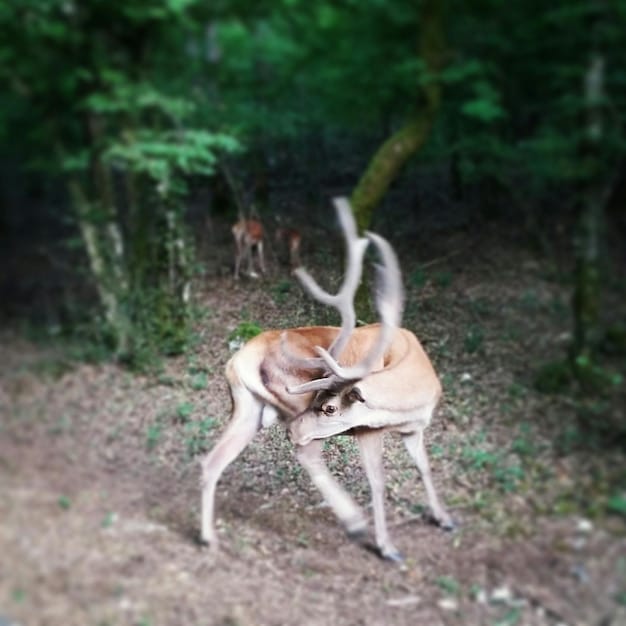Decoding Animal Communication: The Power of Scent and Pheromones

Animal communication through scent, particularly via pheromones, plays a crucial role in the behavior of mammals, influencing everything from mate selection and territory marking to social hierarchies and parental care.
Dive into the fascinating world of animal communication through scent, exploring how mammals utilize pheromones to convey critical information and navigate their complex social landscapes.
The Science of Scent Signals in Mammals
Scent communication in mammals is a sophisticated process that relies on the detection and interpretation of chemical signals. These signals, often in the form of pheromones, are released into the environment and perceived by other individuals of the same species.
Understanding the complex interplay of these chemical cues can provide valuable insights into the social behaviors and survival strategies of various mammalian species.
What are Pheromones?
Pheromones are chemical substances that trigger a social response in members of the same species. They are a form of olfactory communication, meaning they are detected through the sense of smell.
Mammals use pheromones for a variety of purposes, including attracting mates, marking territories, signaling danger, and regulating social interactions.
- Types of Pheromones: Primer pheromones trigger long-term physiological changes, while releaser pheromones cause immediate behavioral responses.
- Detection Mechanisms: Pheromones are detected by the vomeronasal organ (VNO), also known as Jacobson’s organ, in many mammals.
- Chemical Composition: Pheromones can consist of various chemical compounds, each conveying a specific message.

In conclusion, the science of scent signals in mammals hinges on the production, release, detection, and interpretation of pheromones. These chemical signals are integral to the diverse social and survival strategies observed in the animal kingdom.
The Role of Scent in Mate Selection
One of the most critical functions of scent communication in mammals is mate selection. Pheromones play a key role in attracting potential partners and assessing their genetic compatibility.
By analyzing scent signals, animals can make informed decisions about who to mate with, increasing their chances of producing healthy and successful offspring.
Pheromones and Genetic Compatibility
Studies have shown that animals often prefer mates whose pheromones indicate a different set of immune genes. This preference helps to increase the genetic diversity of their offspring, making them more resilient to diseases.
For instance, female mice have been found to prefer males with dissimilar major histocompatibility complex (MHC) genes, which play a crucial role in immune function.
Scent marking, or the act of deliberately depositing scent signals in the environment, contributes significantly to the animal’s role in mate selection. Scent marking plays an important role in attracting potential mates and establishing territories.
In conclusion, scent plays an undeniable role in mate selection of mammals that contributes to the overall health and genetic diversity of animal populations.
Territorial Marking and Scent
Territorial marking is another essential function of scent communication in mammals. Animals use scent to define the boundaries of their territories, signaling ownership and deterring intruders.
This behavior is particularly common in solitary species, where maintaining exclusive access to resources is crucial for survival. But also very important for social species.
- Scent Glands and Territoriality: Many mammals possess specialized scent glands that produce unique chemical signatures for territorial marking.
- Urine Marking: Urine marking is a common form of scent communication, especially in canids and felines.
- Fecal Marking: Some animals use fecal matter to mark their territories, often placing it in prominent locations.
The Importance of Scent in Social Hierarchy
In social mammals, scent marking can also play a role in establishing and maintaining social hierarchies. Dominant individuals may use scent to assert their authority.
Scent Communication as a Means for Social Hierarchy
In social species such as primates and canids, scent marking is intertwined with social status. Dominant individuals often scent-mark more frequently.
In conclusion, territorial marking through scent is a pervasive behavior in the animal kingdom, serving as a means of communication, dominance assertion, and resource protection.
Scent and Predator-Prey Interactions
Scent communication also plays a role in predator-prey interactions. Animals use scent to detect predators and to avoid being detected themselves.
Prey animals may use scent to assess the risk of predation, while predators may use scent to track down prey.

Understanding how scent influences predator-prey dynamics can shed light on the evolutionary arms race between these two groups of animals.
Scent as a Warning Signal
Some prey animals release alarm pheromones when they detect a predator. These pheromones alert other members of the species to the presence of danger, allowing them to escape or take defensive measures.
Predators Utilizing Scent Tracking
Predators often rely on their sense of smell to locate prey. They can track the scent trails left behind by their targets, even over long distances.
The intricacies of scent as a communication tool that helps animals navigate the complexities of predator-prey interactions contribute to the survival of both predator and prey.
Parental Care and Scent Recognition
Scent plays a critical role in parental care, particularly in the recognition of offspring. Many mammals use scent to identify their young and ensure that they receive the necessary care and attention.
This is especially important in species where multiple mothers raise their offspring together, such as in communal nesting situations.
Maternal Recognition of Offspring
Mothers often use scent to distinguish their own offspring from those of other females. This allows them to provide targeted care and prevent misdirected parental investment.
- Scent Imprinting: Young animals may undergo a process called scent imprinting, where they learn to recognize the scent of their mother or other caregivers.
- Olfactory Cues: Mothers and offspring exchange olfactory cues that reinforce their bond and facilitate recognition.
- Weaning and Scent Signals: Scent signals also play a role in the weaning process, as mothers gradually reduce their investment in their offspring.
In summary, scent communication is vital for parental care, enabling mothers to identify and care for their offspring effectively, enhancing the survival of the next generation.
Ethical Considerations in Scent Research
As our understanding of scent communication in mammals grows, it is important to consider the ethical implications of our research. Manipulating scent signals could have unintended consequences for animal behavior and welfare.
Researchers must adhere to strict ethical guidelines to ensure that their work does not harm or disrupt animal populations.
Minimizing Disturbance to Animals
Any research involving scent communication should be designed to minimize disturbance to animals. This includes avoiding unnecessary interference with their natural behaviors and habitats.
Responsible Use of Scent Technology
The development of scent technology, such as artificial pheromones, should be guided by ethical principles. These technologies should be used responsibly and with consideration for their potential impacts on animal welfare.
Ethical considerations are paramount in scent research, warranting careful consideration to mitigate risks while promoting the well-being of the animals under study.
| Key Point | Brief Description |
|---|---|
| 👃 Pheromones | Chemical signals used for communication within the same species. |
| ❤️ Mate Selection | Scent plays a vital role in attracting mates and assessing genetic compatibility. |
| 🐾 Territorial Marking | Animals use scent to define territory boundaries and deter intruders. |
| 🛡️ Predator-Prey | Scent helps animals detect predators or avoid being found by them. |
Frequently Asked Questions
▼
Scent communication in mammals primarily functions to facilitate social interactions, including mate selection, territorial marking, predator avoidance, and parental care. It is a key element of their survival.
▼
Mammals detect pheromones through the vomeronasal organ (VNO), also known as Jacobson’s organ. It is a specialized olfactory sense organ that detects chemical signals and triggers behavioral responses.
▼
Ethical considerations include minimizing disturbance to animals’ natural behaviors and habitats, as well as using scent technologies responsibly to avoid unintended impacts on animal welfare.
▼
Yes, scent can serve both purposes. Pheromones attract mates by signaling reproductive readiness and genetic compatibility, while alarm pheromones deter predators by warning others of potential danger.
▼
Scent recognition helps mothers distinguish their own offspring from others, ensuring that they provide targeted care to their young ones. This is crucial in species with communal nesting behaviors.
Conclusion
In conclusion, animal communication through scent is a pivotal aspect of mammalian life, deeply influencing behaviors from mating and territorial defense to parental care and predator avoidance. By understanding the nuances of pheromones and scent signals, we gain valuable insights into the complex social dynamics and survival strategies of these fascinating creatures.





